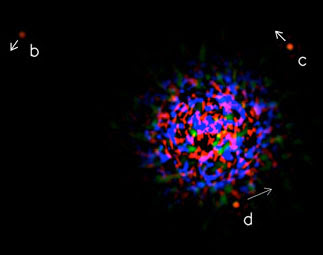The First Images of Exoplanets
 The first photographic images of exoplanets (planets orbiting stars other than our Sun) have recently been reported in sources including Scientific American, Space.com, and NASA. Exoplanets are typically discovered through indirect observation. Direct observation and photography of these worlds is notoriously difficult for a host of reasons: their tiny size (by definition, a planet must be smaller than even a dwarf star), their dimness, and their relatively close proximity to their parent stars, whose bright light drowns them out.
The first photographic images of exoplanets (planets orbiting stars other than our Sun) have recently been reported in sources including Scientific American, Space.com, and NASA. Exoplanets are typically discovered through indirect observation. Direct observation and photography of these worlds is notoriously difficult for a host of reasons: their tiny size (by definition, a planet must be smaller than even a dwarf star), their dimness, and their relatively close proximity to their parent stars, whose bright light drowns them out.
The image pictured comes from the University of California at Berkeley and depicts a planet orbiting a star called Fomalhaut. This composite image from the Hubble Space Telescope shows the planet's position in 2004 (bottom) and 2006 (top); from these data astronomers have calculated and graphed the planet's orbital path. Fomalhaut and its planet are relatively nearby, about 25 light years away. Another amazing image consists of a system of three exoplanets, pictured at left, which have been detected orbiting a star with the unassuming name HR 8799. The Keck Observatory, which sits at the summit of Mauna Kea in Hawaii, claims the honor of creating these images.
Another amazing image consists of a system of three exoplanets, pictured at left, which have been detected orbiting a star with the unassuming name HR 8799. The Keck Observatory, which sits at the summit of Mauna Kea in Hawaii, claims the honor of creating these images.
There is a catch in calling these "the first" images, though. The devil is in the details, which not even many of the science writers reporting these images seem to have caught. As a matter of fact, at least two direct images of exoplanets already exist! I should know, because I wrote an article about them last month. One was taken as far back as 2004, and the other was reported (again, incorrectly as "the first") earlier this year. Oh, how quickly these science writers forget!
Neither the Fomalhaut nor the HR 8799 images are the first direct images of exoplanets.
As nearly as I can tell, the "firsts" for these images are this: the Fomalhaut images seem to be the first planet discovered through direct observation of visible light. The HR 8799 system images seem to be the first family of exoplanets discovered through direct observation of infrared light. The previously existing images I mentioned above, on the other hand, were discovered through the indirect methods that so far have been the main way of detecting exoplanets; the images were created only later.
All of these images are exciting. Planets outside our solar system intrigue the imagination! But please, I wish the science reporters would do a little fact checking and get their stories straight.






